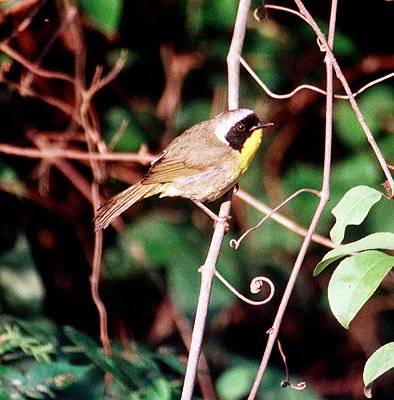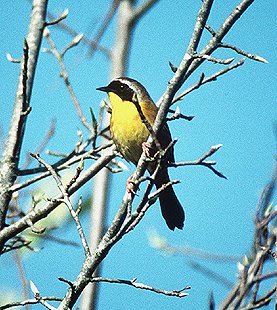|
Reinita Pica Tierra, Common Yellowthroat Geothlypis trichas
|
 |
|
Macho - Foto: G. Beaton
|
|
Reinita Pica Tierra, Common Yellowthroat Geothlypis trichas
|
 |
|
Macho - Foto: G. Beaton
|
|
IDENTIFICACIÓN: La garganta color amarillo brillante, el antifaz negro orlado de blanco y la espalda pardo oliváceo identifican al macho. La hembra no tiene el antifaz negro pero sí tiene un fino anillo blanco alrededor del ojo. Tamaño: 11-13 cm.; peso: 9-10 g. VOZ: La Reinita Pica Tierra tiene un llamado muy distintivo, un ronco "yip". En el área de reproducción el canto es un monótono "wíchiti-wíchiti-wíchiti". Audio 4 (M. Oberle). HÁBITAT: Ciénagas, la orilla de canales y manglares, bosques secos, matorrales y pastizales húmedos con hierba alta. HÁBITOS: Esta ave pasa la mayor parte del invierno escondida en la maleza densa, aunque abandona su refugio para investigar cualquier intruso. Responde con facilidad a un chillido o a lo que en inglés se llama "pishing" (vea el apéndice). A menudo levanta la cola al forrajear en busca de insectos, arañas y algunas semillas. En la zona de reproducción en América del Norte la hembra construye un nido voluminoso escondido en la maleza o en la vegetación palustre alta. Es ella quien incuba los 3 a 5 huevos durante aproximadamente 12 días. Ambos padres alimentan a los pichones, quienes dejan el nido a los 10 días después de salir del cascarón. ESTADO Y CONSERVACIÓN: Un residente invernal común. Sus poblaciones han aumentado con el abandono de fincas en la zona de cría pero la especie comúnmente es parasitada por los tordos. DISTRIBUCIÓN: La Reinita Pica Tierra anida del sur de Canadá hasta el centro de México. Inverna del sur de Estados Unidos hasta América Central y las Antillas Mayores. Una localidad donde se puede encontrar esta especie con regularidad es la Reserva Natural de Humacao. TAXONOMÍA: PASSERIFORMES; PARULIDAE. |
 |
|
|
Macho - Foto: G. Beaton
|
 |
|
|
Macho - Foto: B. Zaremba
|
 |
|
|
Hembra - Foto: G. Beaton
|
 |
|
|
Macho - Foto: G. Beaton
|
|
Referencias Arendt, W.J. 1992. Status of North American migrant landbirds in the Caribbean region: a summary. Pp. 143-171 in Ecology and conservation of neotropical migrant landbirds (J.M. Hagan III and D.W. Johnston, eds.) Smithsonian Instit. Press, Washington, D.C. Bent, A.C. 1953. Life histories of North American wood warblers. Smithsonian Instit. U.S. National Museum Bull. 203. (Reprinted by Dover Press, NY, 1963). Dunn, J. and K. Garrett. 1997. A field guide to warblers of North America. Houghton Mifflin, NY. Ehrlich, P.R., D.S. Dobkin, and D. Wheye. 1988. The birder’s handbook: a field guide to the natural history of North American birds. Simon and Schuster/ Fireside, NY. Guzy, M. J. and G. Ritchison. 1999. Common Yellowthroat (Geothlypis trichas). in The birds of North America, No. 448 (A. Poole and F. Gill, eds.). The Birds of North America, Inc., Philadelphia, PA. Raffaele, H.A. 1989. A guide to the birds of Puerto Rico and the Virgin Islands. Princeton. Raffaele, H.A. 1989. Una guía a las aves de Puerto Rico y las Islas Vírgenes. Publishing Resources, Inc., Santurce, PR. Raffaele, H.A., J.W. Wiley, O.H. Garrido, A.R. Keith, and J.I. Raffaele. 1998. Guide to the birds of the West Indies. Princeton. Wunderle, J.M., Jr. and R.B. Waide. 1993. Distribution of overwintering nearctic migrants in the Bahamas and Greater Antilles. Condor 95:904-933. Reinita Pica Tierra, versión en inglés Próxima especie en el orden taxonómico Especie anterior en el orden taxonómico |
|